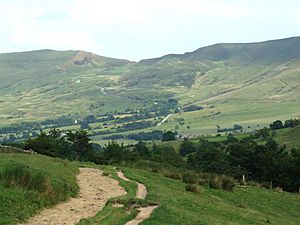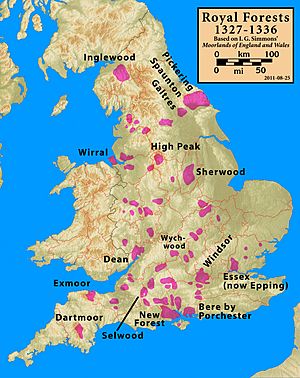Forest of High Peak facts for kids
The Forest of High Peak was a huge, wild area in Derbyshire, England, many centuries ago. It was a moorland forest, meaning it had lots of open, hilly land with heather and grasses. This forest covered most of the northwest part of Derbyshire, reaching as far south as the towns of Tideswell and Buxton.
After the Norman Conquest in 1066, the Forest of High Peak became a special hunting ground for the kings of England. It was managed by a man named William Peverel, who was a supporter of King William I. William Peverel lived at Peveril Castle, which helped him oversee the forest.
The Royal Forest of Peak had natural borders: the River Goyt to the west, the River Wye to the south, the River Derwent to the east, and the River Etherow to the north. By the year 1305, this vast forest covered about 100 square miles!
Contents
Inside the Forest of High Peak
The Forest of High Peak was divided into different areas. One part, located between the River Wye and Kinder Scout, was quite open. It had a low wall built around it. This wall was just tall enough to keep farm animals like cattle and sheep out, but it allowed wild deer to move freely. This open area was known as Campana. The other two main areas were called Hopedale and Longdendale. Even today, the spot where these three areas met is marked by the Edale Cross.
Who Owned the Forest?
Besides looking after the forest, William Peverel also controlled many smaller estates, called manors. These manors were part of a larger property known as the Honour of Peverel, which was recorded in the famous Domesday Survey. William's son, who was also named William, was given even more manors. This meant the Peverel family considered the forest and its surrounding lands their own, except for a few manors that belonged to another important family.
Changes in Ownership
However, things changed in 1154. King Henry II took control of the Peverel family's lands. He later rebuilt Peveril Castle in 1176.
Years later, in 1189, King Richard I gave the Honour of the Peak to his brother, John, who was Count of Mortain. Later, King Edward II briefly gave it to his close friend, Piers de Gaveston. Then, under King Edward III, the forest passed to John de Warenne, Earl of Surrey, in 1345.
When John de Warenne died in 1347, the forest went to King Edward III's wife, Philippa of Hainault. Finally, in 1372, it was given to John of Gaunt, 1st Duke of Lancaster. When John of Gaunt's son, Henry IV, became king, the Honour of the Peak, along with all the other lands of the Duchy of Lancaster, became part of the Crown's property. Much later, the Forest of High Peak was leased forever to the Dukes of Devonshire.
Animals and Rules of the Forest
Records from the past tell us about the animals that lived in the Forest of High Peak. There were deer, wild pigs, wolves, horses, and sheep.
If someone broke the rules of the forest, they would be taken to the Peak Castle at Castleton. This was where the High Steward, a special official, managed the forest and its laws. The village of Peak Forest today is right in the middle of where the old royal forest used to be. It was once known as Chamber of Campana. A nearby place called Chamber Farm or Chamber Knoll might have been where the local forest officials lived and held their meetings.



